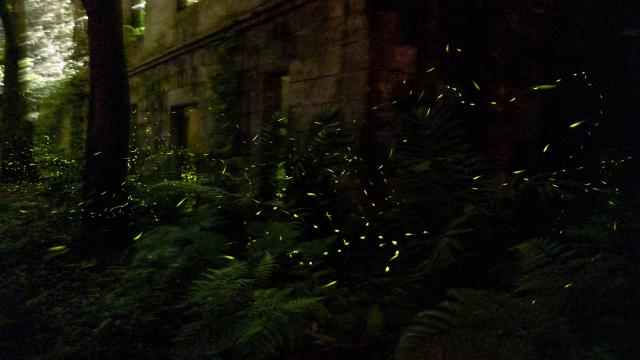Nights on Earth are getting brighter with the spread of human light pollution, reducing humankind’s visibility of the cosmos. But the brightening night is also messing with glow-worms, spunky insects that rely on their luminous abdomens to procreate.
Common glow-worms (Lampyris noctiluca) are found across Europe, Africa, and parts of Asia. Despite their name, the worms are beetles. They’re toxic, and eat snails as juveniles.
Both sexes of the insect are legged, and males are also winged. Females of the species use their glowing abdomens to attract mates, being incapable of flying around to find one.
A team of researchers recently collected glow-worms from southeastern England and brought them into a lab setting to test artificial light’s effect on the worms’ navigation. Their results were published today in the Journal of Experimental Biology.

“The ability of male glow-worms to find female glow-worms is severely affected by artificial white light,” said Jeremy Niven, a zoologist at the University of Sussex and a co-author of the research, in an email to Gizmodo.
“This is a problem for glow-worms because their mating relies on females producing a bright glow from their abdomen, a form of bioluminescence,” Niven added. “If the males can’t find the females’ glow then they can’t reproduce and the population may suffer.”
The researchers put male glow-worms they collected in a darkened Y-shaped maze in the lab. In the maze, the males were shown a green LED, made to mimic the female’s luminous abdomen. These tests were then done with a white light above the maze at dim levels of white light and harsh white light, similar in luminosity to a street lamp.
About 70% of the insects found the green LED in dim white light, and only 21% found it under the brightest light. The glow-worms that made it to the green LED also took longer to reach the light when white light was present.
Though other studies have indicated glow-worms are disappearing from the meadows and heaths they inhabit, Niven said it’s not possible to say whether that’s due to artificial light versus other threats, like climate change and habitat loss.
That’s not to say the average person can’t help. “Perhaps the simplest thing the average person can do is to turn off garden lights and to generally reduce outdoor lighting, and close curtains in rooms where indoor lighting is being used,” Niven said. “This has the added benefit of saving energy and money.”

Night lights don’t just threaten glow-worms. They can bewilder birds migrating at night, which rely on constellations to orient themselves on their often-intercontinental commutes. And at the same time, they can vex astronomers, as the light pollution on Earth makes it increasingly difficult for ground-based telescopes to see the stars.
“The sort of initiatives that try to protect/restore dark skies for astronomers are likely to also be beneficial for glow-worms,” Niven said.
Many of humankind’s inventions to mould Earth’s landscape to our liking have had deleterious side-effects, on other life forms but also (counterintuitively) scientific inquiry. Since artificial light is only going to become more omnipresent (on Earth and above it), it’s crucial that we develop ways to reduce its harm to the environment.
